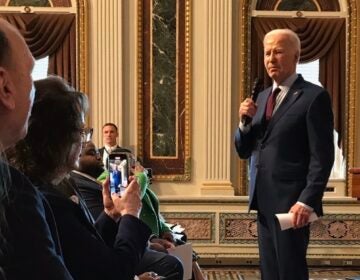Delaware trying to make solar more affordable
A hundred acres of farmland in Dover is home to the future 10 megawatt Dover Sun Park.
Currently 17,000 solar panels that move with the sun have been installed. And by mid-July when the $58 million project is expected to be completed, Dover leaders say there will be 34,250 panels in all.
“When you get to see it finished, I think it’ll be awesome to look at because, even now, only half the panels are up, but you see solar panels everywhere,” said Dover Mayor Carleton Carey.
With the flip of a switch, the solar panels are expected to generate hours of clean energy, power about 1,300 homes and help utilities, like Delmarva Power, meet Delaware’s lofty renewable energy standards.
“There are clean energy goals that the state of Delaware has with respect to ensuring that a portion of our electricity supply does come from clean, renewable sources and we’re supportive of those goals and we’re working toward meeting those goals,” said Bridget Shelton with Delmarva Power.
Last summer, the General Assembly passed Senate Bill 119 requiring 25 percent of Delaware’s electricity comes from cleaner sources by 2025. Solar has to account for 3.5 percent.
“Our 25 percent goal is among the more aggressive in the country, but at the same time’s it’s achievable,” said Collin O’Mara, Secretary of Delaware’s Department of Natural Resources and Environmental Control (DNREC).
Achievable thanks to projects like the sun park because solar generates what are called solar renewable energy credits, or “SREC’s” for short.
“Basically because your utility didn’t have to fire up a coal-fired power plant or a nuclear power plant somewhere to give you electricity, because you generated your own solar electricity, that creates the Solar Renewable Energy Credit,” said Dale Davis, President of CMI Solar Electric, a solar installer based in Newark.
Utilities need so many SREC’s each year to meet state regulations. Dover’s Director of Economic Development Bill Neaton says statewide utilities have agreed to purchase some of the park’s SREC’s. Delmarva is slated to buy 70 percent of them.
Delawareans with solar powered systems also generate SREC’s, which they can sell to their energy providers who need the credits; and that means extra money for you in the form of a check each year that can go towards paying off your solar investment.
Davis says when you add the savings each month on your utility bills to federal and state incentives, the average residential customer breaks even on their systems in about seven years, small businesses in less time than that.
Solar powered systems are cheaper than they were five years ago, but Davis says they can still run you $10 to $35-thousand. Currently, the federal government’s offering a 30 percent tax credit while the state’s offering about a 25 percent rebate. But people still aren’t jumping on the solar bandwagon, because Davis says getting financing from the bank for the remaining balance still gets in the way. So the state is trying to make it easier.
“We decided to create a task force that had representatives from a lot of different parts of the state to actually come together and figure out how do we have incentives that are smart and that don’t over-incentivize the project, but at the same time provide enough of an incentive for someone to put a system on their house or their business,” said DNREC Secretary O’Mara.
Davis is part of this task force representing solar installers, manufacturers and customers. They make up DSEC — Delaware Solar Energy Coalition.
“What we’re doing is putting together a program where, have a procurement program for those renewable energy credits that are actually 20 year contracts… When you have that contract in place, then the bank can look at it and say, ‘Okay, these credits are financeable, we can include that as part of the income and move forward with the system,'” said Davis.
DNREC says the contract program should be good to go in about two months, clearing the way for more solar installations, creating jobs and helping the environment all at the same time.
WHYY is your source for fact-based, in-depth journalism and information. As a nonprofit organization, we rely on financial support from readers like you. Please give today.




